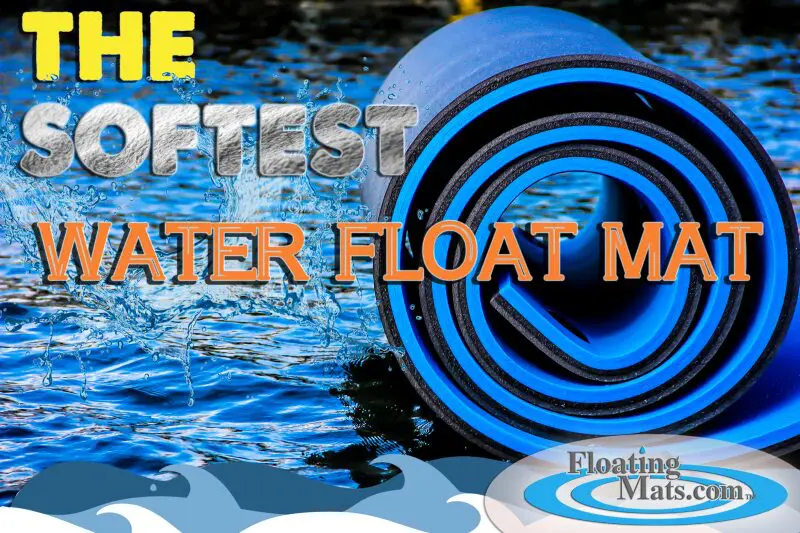Inflatable water mats have become increasingly popular in recent years as a fun and convenient way to enjoy time on the water.
That’s all well and good, but while these mats may seem like a great option for families and individuals looking to relax and have fun in the sun, there are significant drawbacks and potential dangers that you should be aware of when considering the best floating mat for you and your family.
Obviously, we here at FloatingMats.com have a dog in this fight as the makers of 100% American-sourced and American-made foam floating mats.
But the whole reason our family-owned company was started, over 10 years ago, was to bring the safest, highest quality, and most convenient floating mat possible to other water lovers like us.
We spend our weekends on the water, just like you, and that’s why we feel it’s important that you know the potential problems with inflatable floating mats.
Let’s take a closer look at the various concerns associated with inflatable water mats, including punctures and rips, difficulties in transport, and repair, and, yes, environmental and health concerns.
By the time we are done here, you’ll have a better understanding of the problems with inflatable water mats and why a floating foam mat is almost always the better choice.
Punctures and Rips
One of the primary concerns with inflatable water mats is their tendency to puncture and rip.
While these mats may seem durable, they are actually quite fragile and can easily be damaged by sharp objects such as rocks, sticks, or anything else sharp – both above and below the water’s surface.
And when this does occur, it can quickly lead to a dangerous situation for users if there isn’t safety nearby.
Blown-Out Seams
In addition to punctures and rips, inflatable floating mats are prone to blow-out seams.
The seams on these mats can blow out due to a number of factors, including
- over-inflation
- general wear and tear
- UV exposure
UV exposure will weaken the material of these mats (more on that below) over time, making them more susceptible to tearing and seam separation.
These 3 things, when they all come together, can really pose a problem and take the fun out of your day on the water with quickness.
Repair Difficulty
Inflatable water mats are also difficult to repair, even with the manufacturer’s repair kit.
Because the material of these mats is thin and fragile, it is difficult to patch up or replace sections without causing further damage.
Additionally, many of these mats are seamed together in a way that makes them even harder to repair without taking apart the entire mat.
Hard To Use
In addition to punctures and rips, there are several other potential drawbacks and dangers associated with inflatable water mats.
Too Rigid
Inflatable water mats are often too rigid to use comfortably. Because they are made of thin, inflatable material, they can be difficult to lounge on and may not provide the same level of comfort as foam mats.
Additionally, these mats can be too rigid for small children and pets (OK, adults too!) to climb onto, making it difficult to safely use the mat.
Inflation and Deflation
Inflatable water mats can also be difficult to inflate and deflate. Even with an electric pump, they can take a long time to fully inflate and can be tricky to deflate without damaging the material.
This makes them more time-consuming to set up and take down, which can put a damper on your day of fun on the water.
The pumps themselves can be loud and potentially blow fuses in boats, which can be both inconvenient and dangerous and a whole different problem to derail your day of fun.
Heavy and Cumbersome
Inflatable water mats are also quite heavy and cumbersome, making them difficult to transport and store.
Compared to a floating foam mat, that can be rolled up and easily transported on your boat, inflatable mats are not nearly as easy to move around with you during your day on the lake.
Health Concerns
In addition to the potential for punctures, rips, and blow-out seams, inflatable water mats can also pose health concerns.
This is because many of these mats are made from PVC (polyvinyl chloride ), a type of plastic that is known to contain potentially toxic chemicals, such as phthalates and lead.
The chemical composition of these mats can lead to various health issues for users who are exposed to them on a regular basis, including skin irritation and respiratory problems.
Environmental Concerns
While the potential health risks associated with inflatable water mats may be concerning enough, their environmental impacts are even more troubling.
Many of these mats are made from vinyl chloride (PVC), which is not only toxic to humans but also pollutes the environment.
Our foam floating mats at FloatingMats.com are made of cross-linked Polyethylene foam and contain NO vinyl chloride (PVC)!
In addition, because these mats are so difficult to repair, they often end up in landfills where they will remain for many years. And that is not good for anybody.
Consider Foam Water Mats as a Safer Alternative
From the risk of punctures and rips to health and environmental concerns, there are many factors that should be considered before purchasing an inflatable water mat.
If you’re looking for a safer and more reliable alternative, consider a foam water mat instead.
With a floating foam mat from FloatingMats.com, you will be getting a mat that is:
- More durable, puncture resistant, and less prone to rips
- Less rigid and safer for children and pets to use (and adults to climb on!)
- Quicker and easier to set up and use, no inflation or deflation required
- Environmentally friendly, made from non-toxic, 100% American-sourced recyclable materials
What are you waiting on?
Head over to our Shop page and find the right floating foam mat for you!


